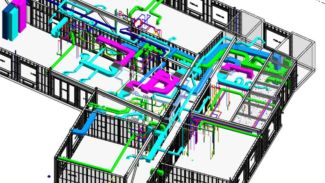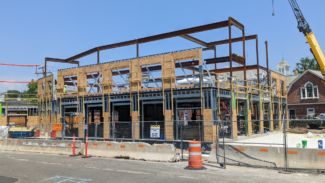Metal stud bridging, or metal stud bracing, refers to the reinforcement of metal stud wall framing to prevent buckling or twisting.
Bridging reinforcing will vary depending on the project, but one of the most common options is ClarkDietrich’s Spazzer® bridging bar, which is a “prenotched bridging and spacing bar that facilitates the rapid erection of exterior and interior, load bearing and non-load bearing, studs into a rigid, accurately laid out wall that has excellent resistance to stud rotation and displacement.”
These bars are both used to brace wall studs either along the height of the wall or as the top-of-wall deflection track.
There are options for both interior and exterior framing:
- The Spazzer 9200 is a 20-gauge (33 mil) bar that is 50” long and prenotched to hold studs 16” and 24” on-center. The 9200 bar is only for interior wall use.
- The Spazzer 5400 comes in 16-gauge or an 18-gauge option that is 50” inches long and prenotched at intervals of 12”, 16”, and 24”. The 5400 bar is for exterior wall use.
Both are used to brace wall studs either through the height of the wall or at the top of the wall.
Spazzer Bar Installation
Benefits of Using the Spazzer Bar
Spazzer Bar Installation Challenges
Different Types of Metal Stud Bridging
Different Types of Metal Stud Bridging
As ClarkDietrich explains, the Spazzer bar is installed in two different ways depending on whether you are dealing with load bearing or non-load bearing studs.
- Load-bearing studs: The bar is passed through the stud knockouts and rotated 90° into position, engaging each side of the knockout. The Spazzer snap-in grommet, Spazzer bar guard, or Spazzer Bar Fly Clip is required.
- Non-load bearing studs: The bar is passed through the stud knockouts and rotated 90° into position. For 20-gauge studs, one of the following is required: the Spazzer bar guard, Spazzer Bar Fly Clip, or Spazzer snap-in grommet.
Benefits of Using the Spazzer Bar
The advantages of using the Spazzer bar include:
- Notches at 12” and 16” on-center, which means no measurements are required.
- The bar allows you to assemble studs more quickly and more productively, which can save time and money on a project.
- The bar provides resistance to stud rotation and displacement and is an excellent option for bracing stud walls.
- There is variability in length.
Spazzer Bar Installation Challenges
Although the Spazzer bar is a common bracing choice, it does comes with a few challenges:
- The stud framing must be 12”, 16”, or 24” on-center. Walls with lots of windows or doors that don’t have long runs of unobstructed walls may not find this product helpful.
- It’s important to ensure the knockouts are aligning from stud to stud, which can be challenging in a wall with a lot of doors and windows.
- The Spazzer bar can only be used for studs 8” or smaller.
- If the studs are 20-gauge or smaller, the Spazzer bar must be anchored.
Different Types of Metal Stud Bridging
In addition to the Spazzer bar, there are two other common types of metal stud bracing:
- Cold-rolled channel: This is a heavy-gauge channel shape that runs through the knockouts and is fastened to the studs using angles or proprietary clips.
- Continuous straps with blocking: This type of bracing is the least specific to a particular manufacturer. Continuous straps are used on both sides of a wall with a piece of track/stud blocking at 8 feet on-center.
If you have any questions about metal stud bracing or would like to request a quote for your next project, contact us today.


